The Pacman Frog is a colorful amphibian native to many countries in South America.
This species is nicknamed pac-man because of its large triangular mouth and round body. They look just like the Pac-Man arcade character!
Due to this largemouth, they are a hands-off pet as they have a tendency to bite anything that moves.
If you are looking for a pet frog that is eye-catching and low maintenance then this amphibian species is perfect for you.
Continue reading to learn everything you need to know about how to care for a Pacman Frog…
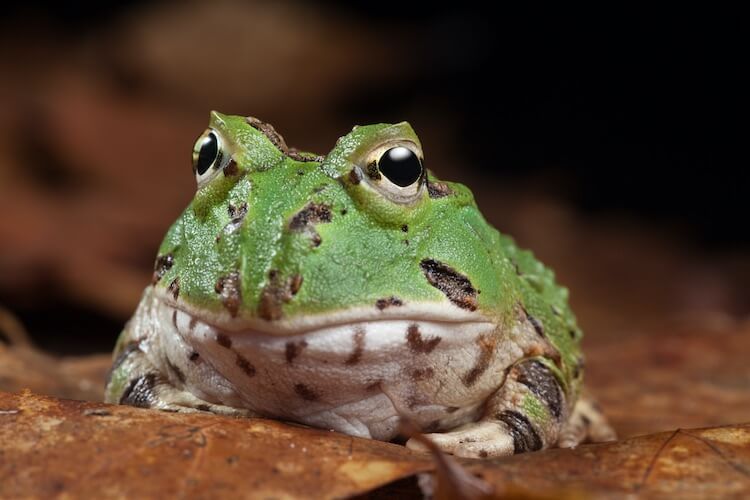
Pacman Frog Overview
Pacman frogs are found exclusively in the rainforests and coastal forests of South America. It is common to find them in Brazil, Ecuador, Columbia, and Peru.
It is hard to mistake a pac-man frog for any other amphibian.
They have famously wide mouths and horns over each eye. These horns lend them their other common name, the horned frog.
Species of Pac-Man Frogs
There are eight species of pacman in the wild, all of which are very similar in appearance.
These eight species are from the genus Ceratophrys and are also known as South American horned frogs.
Brazilian Horned Frog
The first species discovered was the Brazilian horned frog in 1823. The eighth and latest species was found in 1986. However, given the amount of unexplored rainforest in Brazil, it is possible there are other species yet to be discovered.
Which Species Of Pac-Man Frog Make the Best Pet?
Surinam horned frogs, Argentine horned frogs (aka Ornate horned frogs), and Cranwell’s horned frogs are the ones that make the most popular pets. These frogs are known for their ornate patterns and voracious appetites. They have an ability to eat animals nearly as large as themselves (e.g. locusts, mice, fish, and other frogs).
Unlike North American frogs, this species is terrestrial and not aquatic. Their lifestyle is closer to toads.
Pacman frogs spend most of their time half-buried in leaf litter waiting for prey.
They are most active at night and during the rainy season when breeding occurs. During the dry season they go through a dormant period (i.e. estivate).
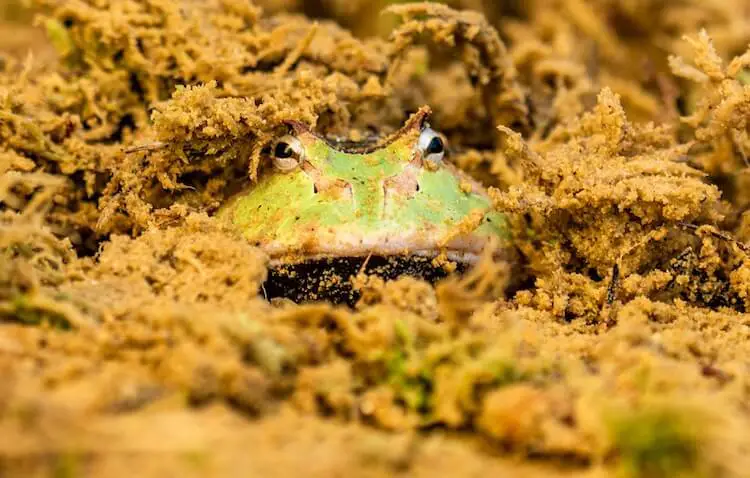
Are Pacman Frogs Good Pets?
Pac-mans make a great pet frog. The Surinam horned, Argentine horned, and Cranwell’s horned frogs make the best choice for a beginner.
They live well in captivity and settle quickly into their enclosure.
When you bring your frog home let him adjust for three days without any disturbances.
We recommend you do not handle this species. However, you can still learn a lot from observation.
During his first few weeks, you will see him moving around looking for the best spot to burrow. Once he finds his favorite place it is likely he will remain there for some time.
Pros And Cons
Pros
- Large size and rapid growth with females reaching seven inches.
- Lots of unique morphs and colors to choose from.
- Simple and easy diet as they will eat nearly anything.
- A sedentary lifestyle means that they do not need a large enclosure.
Cons
- Aggressive towards other species so must be housed separately.
- Not suitable for handling and is prone to biting.
- Not active during the day and spends most of its time buried.
Species Appearance
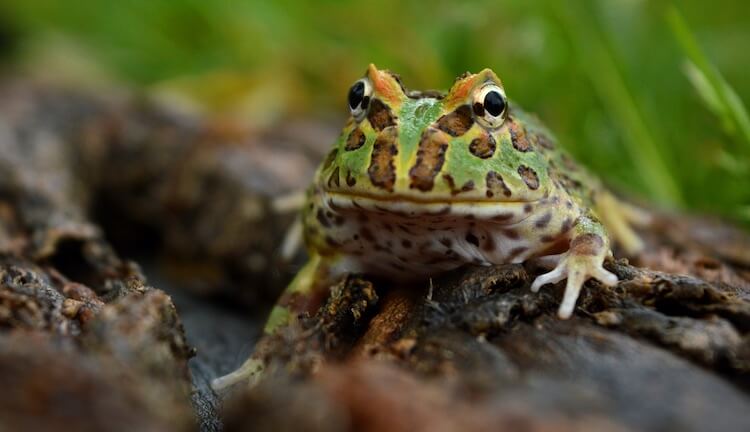
Wild species are generally brown or muddy green with dark brown spots.
As they age they often change color and pattern.
Do not be surprised if an adult looks slightly different from the juvenile you adopted.
There are slightly noticeable differences between the three most popular pet species:
- The Surinam horned (Ceratophrys cornuta) has larger and pointier horns with a solid green or brown head. They also have light-colored eyes with a horizontal stripe through the pupils.
- Cranwell’s horned (Ceratophrys cranwelli) has much smaller rounded horns. They have a round snout and are patterned with brown or red spots and ovals.
- The Argentine horned (Ceratophrys ornata) has pointed horns and a square head. They have dark green or brown stripes and blotches.
Captive breeding has led to the development of many Pacman frog morphs. Popular morphs include the strawberry and albino.
The most widely bred morph is the albino.
Albinos have a pink and yellow pigmentation instead of the usual green and brown. An albino frog can be distinguished from the similar strawberry morph by its light pink eyes and greener hue.
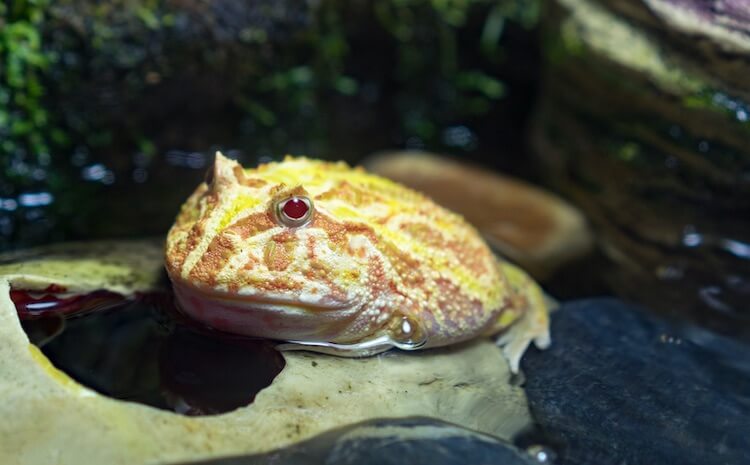
Pacman Frog Size
They have robust legs and a sturdy skull that takes up much of their body. They are known for being stocky frogs.
Full-grown Pacman frogs can reach over one pound in weight. However, it is more common for them to weigh half a pound.
Females grow significantly larger than males and can reach seven inches in size. Males average three to four inches in body length.
After metamorphosis (i.e. from a tadpole to froglet) Pacmans grow amazingly fast. They reach their adult size in just over one year!
Pacman Frog Care
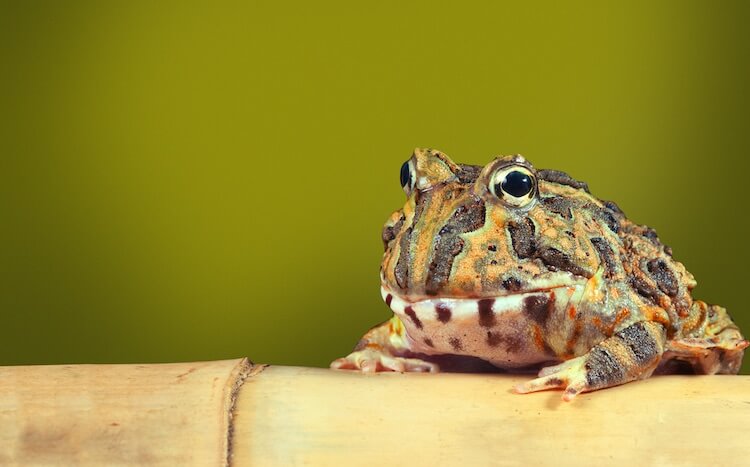
Pacman Frog Diet
Carnivores
Pacman frogs are opportunistic carnivores. This means Pacman frogs eat any animal that will fit in their mouth.
In the wild, these amphibians prefer to sit and wait for animals to wander past – instead of actively hunting prey. Their dark green and brown mottled coloring allows them to blend in with the leaf litter on forest floors.
They regularly eat small prey such as ants and mites but also eat larger vertebrates such as mice, snakes, and other frogs.
In captivity, froglets should be fed earthworms and insects such as crickets and dubia roaches.
Waxworms and mealworms can be given as an occasional treat. However, they contain high fat and fiber levels, so they should not be a major part of the diet.
How Often To Feed A Pacman Frog?
Growing frogs should be fed five crickets or roaches every day.
Dust these insects with a calcium powder before feeding. This will help to ensure your frog maintains sufficient levels of vitamin D3.
The best rule of thumb is to feed as much food as it will eat in 15 minutes. After 15 minutes remove anything that is uneaten.
As your pet grows its appetite will slowly decrease.
Adults only need to be fed every other day. Adults can be offered a pinkie mouse once every two weeks.
Pacman frogs are eager eaters and have a powerful bite. To avoid painful bites you may want to feed them with tongs.
Health and Lifespan
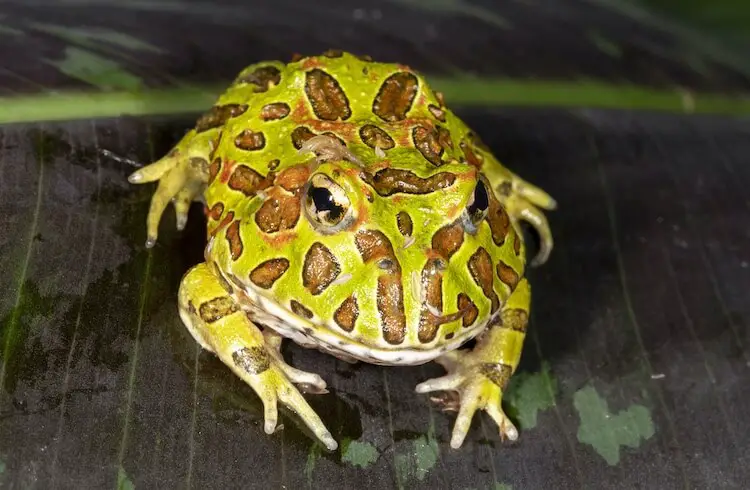
Lifespan
These amphibians have a lifespan of 10 years.
Pacman frogs live for one to five years in the wild.
In captivity, with proper care and good husbandry, they can live for up to 10 years.
Keeping Your Pacman Frog Healthy
Signs they are healthy include:
- Strong appetite.
- Moist skin.
- Clear eyes.
- Round body.
Most health problems (e.g. vitamin A deficiency, metabolic bone disease, and bacterial infections) are caused by a poor diet or bad husbandry.
- Vitamin A deficiency symptoms include rough skin, swollen eyelids, and a build-up of fluid around the hind legs. This condition can be prevented by feeding crickets that have been gut-loaded.
- Metabolic bone disease results from a vitamin D3 deficiency.
- Reptiles with metabolic bone disease are not able to produce enough calcium to build strong bones. As a result, they will have bendy legs and arms, warped mandibles, and a curved spine. If caught early it can be treated with injections of vitamin D3 below the skin.
Pacman frogs are also highly susceptible to bacterial infections. This is because of their thin skin and humid environment.
Red leg syndrome and flavobacteriosis are two commonly diagnosed bacterial illnesses in this frog.
Both conditions are caused by dirty substrate or water and stress.
Pacman Frog Setup
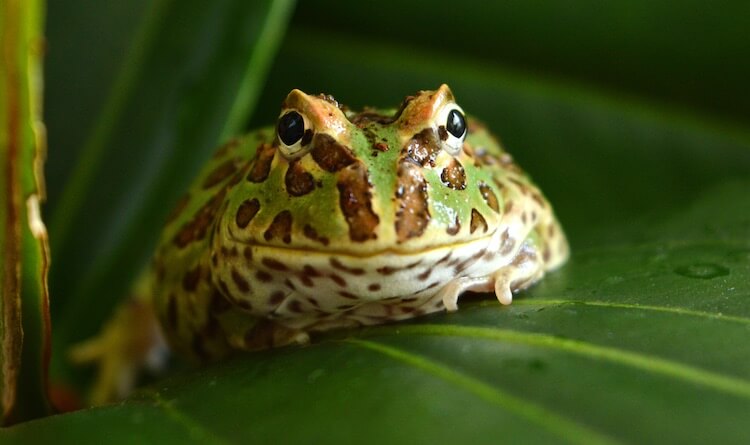
Pacman frog’s natural habitat is both tropical and dry forests.
They tend to live close to tree roots, low branches, and other forms of cover. They use this cover to hide from predators and ambush prey. It is also common to find them near small temporary pools.
When setting up a Pacman frog’s enclosure the two most important factors to consider are humidity and substrate.
These amphibians like to burrow.
Their substrate should be three to four inches deep and nonabrasive so they can bury themselves.
Coconut fiber is the best choice because it is soft, retains moisture, and is cheap to buy in bulk. Keep the coconut fiber damp but not wet. Squeezing the substrate should yield a few drops of water.
Humidity is another important factor in keeping a healthy frog.
Too little moisture can prompt dormancy. Too much can lead to skin infections.
The ideal humidity for a Pacman frog is 70 to 80%.
Set Up Tips
- Tank Type: glass or plastic.
- Tank Size: 20-gallon long tank.
- Lighting: heat bulb.
- Substrate: coconut fiber.
Tanks
For this species, tank width is more important than height.
Adults can live in a 20-gallon long glass tank that measures 30”x 12”x 12”.
Glass or plastic tanks are both resistant to warping from high humidity and allow for easy viewing.
Maintain a daytime temperature of 77 to 83°F and a night-time temperature of 70 to 75°F. If kept in a warm room Pacman frogs are fine with a heat bulb during the day. Avoid using under-tank heatmats. Any under-tank heater can burn a burrowing frog.
Make sure to include live plants and leaf litter in their tank too. Both are great for providing your Pacman with hiding spots.
Finally, provide your frog with a wide and shallow water dish.
The dish should be big enough so your frog to soak without becoming fully submerged. Pacman frogs are not good swimmers and may drown if their water bowl is too deep.
Clean out the bowl daily and refill it with chlorine-free water.
Behavior
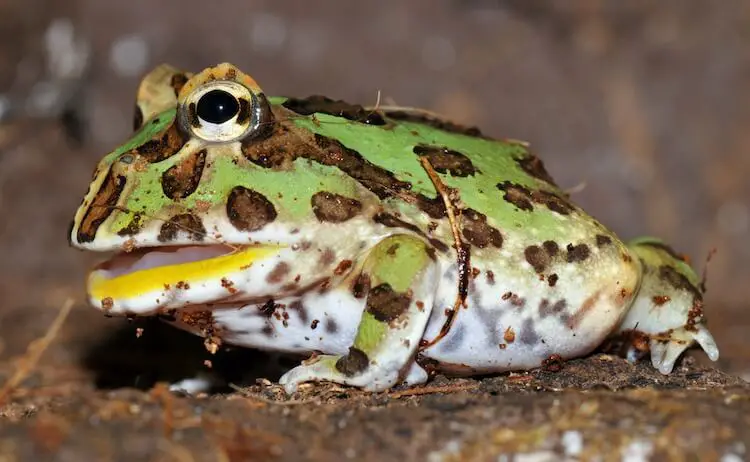
Pacman frogs are notoriously territorial.
They will not hesitate to bite other frogs that come near their burrow. Because of this reason, it is best to only keep one frog in an enclosure to avoid injury or death.
During the day your Pacman will spend its time burrowed in its substrate.
He will either be completely buried or with the top of his head poking out. This is where they are at their happiest and will spend most of their time.
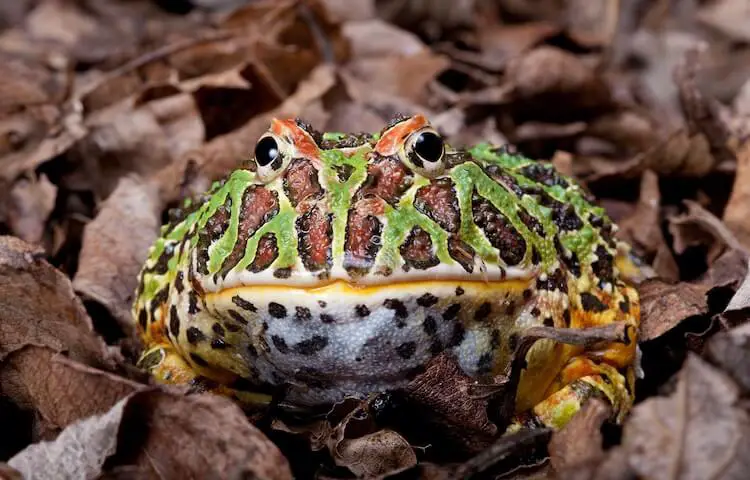
This species is a nocturnal ambush predator.
Because of their sit-and-wait hunting tactics, pacmans do not need a wide space to roam.
At night your frog may come out of its burrow to soak, stretch or explore. Do not expect a great deal of movement.
Do not be concerned if your frog appears to have not moved in a day or two. Unless they are showing other signs of stress or illness there is no need to worry.
These frogs are normally only active when attacking prey.
Can You Touch Pacman Frogs?
Pacman frogs should only be handled when absolutely necessary.
Their thin skin can easily absorb toxins and they are prone to biting.
In fact, large species have a bite force of 500 Newtons. That is the same as putting a 112 pound weight on the end of your finger.
If you need to hold a Pacman, then wash your hands thoroughly and make sure they are free from any lotions or perfumes before touching your frog.
Gently but firmly grasp your frog behind the front legs. If your frog is too large to hold with one hand, hold it with both hands like you would a hamburger.
Buying A Pacman Frog
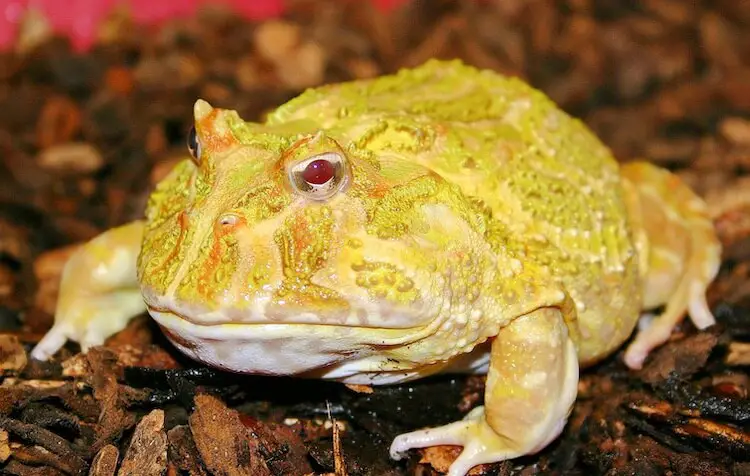
Pacman frogs are usually sold as juveniles. The four most popular species of Pacman frog are:
- Surinam horned.
- Argentine horned.
- Cranwell’s horned.
- Fantasy horned.
All of these species are widely available in the pet trade at reptile expos and from private breeders.
Look for a frog that has all its fingers and toes intact, with clear, open eyes and even skin.
Frogs that are injured by another frog can quickly develop an infection after the stress of moving to a new home.
If you can, ask to see the frog eat. The largest personality trait of Pacman frogs is their ferocious appetite. Try and pick an individual that enthusiastically eats its food.
How Much Does A Pacman Frog Cost?
Normal Pacmans sell for $15 to $30.
The more popular Surinam species is more expensive and costs $45 to $60.
Common morphs such as the albino are sold for around $35. Rarer morphs like the teal and pastel species can cost $80.
Pacman Frog Facts
| Common Name | Pac-man, South American horned frog |
|---|---|
| Scientific Name | Ceratophrys sp. |
| Price | $15 to $30 |
| Size | 3 to 7 inches long |
| Lifespan | 10 years |
| Diet | Crickets, dubia roaches, mealworms, superworms, mice and waxworms |
| Humidity & Temperature | Daytime temperature: 77℉ to 83℉ Nighttime temperature: 70℉ to 75℉ Humidity: 70% to 80% |
| Popular Alternatives | Pixie Frog, American Toad |
Summary
Pacman frogs are excellent pet amphibians for beginners. They come in many beautiful color morphs and are famous for their Pacman-like appearance.
With routine husbandry and a correct setup, these frogs are easy to care for and can live for 10 years.
Their feeding habits are also simple and entertaining to watch.
This species is not a good choice for anyone who wants to handle their pet. Their strong jaws and sharp teeth can inflict a painful bite!
Are you interested in owning one of these unique pets? Let us know in the comments.

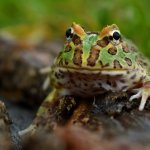

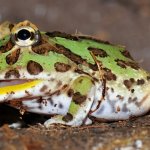

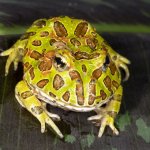
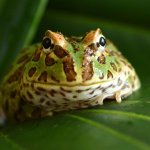
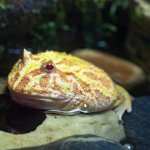
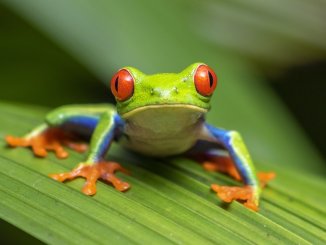
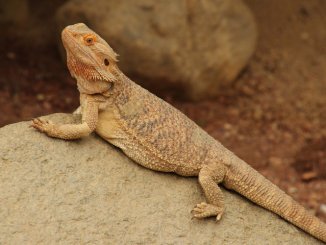
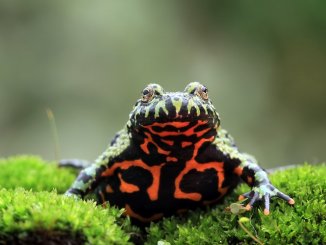
Just trying to find out what the body temperature of a Pac-Man frog is?
Putting a large soaking area in his terrarium and would like to know where to set the water temp
During the day, an adult PacMan frog needs a temperature range between 75 and 80°F (24-27°C), while at night this would be reduced to 65-70°F (18-21°C). In terms of water, you get a similar situation: anything above 70 and below 85 would work in my opinion, but you might want to look at more specific info.